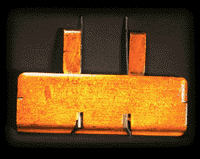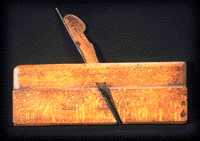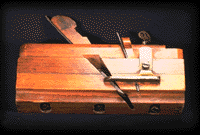
Precursors to Iron Combination Planes
Once you could purchase any of several hundred different wooden planes, each with a slightly different profile and each meant for a different task. In addition to the "standard" designs, permutations were offered in different combinations of woods, handles, and boxing. There were also regional differences in style to choose from. The samples below just provide a small percentage of once was readily available.


Combination Side Snipe Bill Pane
Normally snipe bill planes were provided in left and right hand pairs to enable smooth
planing no matter which direction the grain went. They were used as trimming planes to
improve mouldings and with hollows and rounds![]() to create new mouldings from scratch. There were two types, side snipes
and sinking snipes. This combination side snipe acts very much like a side rabbet plane,
and is used for trimming the edges of rabbets and dadoes. This plane can be stamped
"Currie, Glasgow" and was made sometime between 1833 - 1844.
to create new mouldings from scratch. There were two types, side snipes
and sinking snipes. This combination side snipe acts very much like a side rabbet plane,
and is used for trimming the edges of rabbets and dadoes. This plane can be stamped
"Currie, Glasgow" and was made sometime between 1833 - 1844.



